Mahogany & "Construction of Volume Relations"
Introduction
A trip to the Museum of Modern Art (MoMA) in New York will introduce you to an array of inspiring and captivating works of art. One of the pieces that commands attention and sparks curiosity is Georges Vantongerloo's 'Construction of Volume Relations', a sculpture that can lead you on a mesmerizing journey of thought and reflection, particularly if you have an affinity for abstract art.

(photo from the MoMA)
Created in 1921 by the Belgian artist, Vantongerloo was part of the De Stijl movement and the abstract art movement, which sought to break away from tradition and reveal the world in a new, non-representational way. Vantongerloo's work, in particular, was deeply influenced by the idea of creating harmony and order through mathematical relationships, much like the golden ratio employed by architects and artists throughout history.

(photo from the MoMA)
'Construction of Volume Relations' embodies these principles, illustrating Vantongerloo's mastery of mathematical aesthetics and profound exploration of spatial relations. It is a geometric sculpture made of mahogany wood, characterized by a series of intersecting planes that create a dynamic, three-dimensional form. But just as the allure of the sculpture lies in its aesthetic and abstract expression, the choice of mahogany for its construction reveals an intricate tapestry of history, ecology, and cultural significance, which we will explore in this article.
The mahogany tree
Mahogany trees are renowned for their beauty and imposing stature. These tropical hardwoods often reach a height of 30 to 40 meters, but under optimal conditions, they can grow even taller. Some specimens have been reported to reach up to 60 meters high with a diameter of over 1.5 meters. These trees feature a straight, robust trunk that supports a broad, round canopy, giving the tree an overall symmetrical appearance.

The bark of a mahogany tree is usually dark brown to gray, with a texture that is smooth in young trees but becomes more fissured and scaly as the tree matures. Mahogany leaves are typically compound, with three to six pairs of glossy, dark green leaflets that contrast beautifully against the tree's reddish-brown wood. The tree produces small, fragrant flowers that attract various pollinators. Following flowering, the tree develops unique, capsule-like fruits. When mature, these fruits split open to release winged seeds that are dispersed by wind, ensuring the tree's propagation.
The wood of the mahogany tree is characterized by its rich reddish-brown color, which deepens over time. The grain of the wood is generally straight, making it easy to work with and contributing to its wide use in furniture and other items. The timber is also highly resistant to rot and decay, adding to its durability and desirability.
The mahogany forest
Mahogany trees serve as pivotal species in their ecosystems, providing food, shelter, and contributing significantly to the overall health and vitality of the forests in which they exist. Their roles are complex, extending from their lofty canopies to their deep-reaching roots.
One of the most apparent roles of mahoganies is as a food source. Their fruit, a five-valved capsule enclosing numerous winged seeds, serves as nourishment for a range of wildlife. Various bird species, such as parrots and toucans, heavily rely on these seeds for their diet. In doing so, these birds serve as agents of seed dispersal, aiding in the propagation of mahogany trees throughout the forest, fostering their existence and expansion.

Simultaneously, mahogany trees offer shelter and habitat to a diverse array of species. Their grandiose trunks and branches, characterized by their robust strength and resilience, are ideal dwellings for tree-dwelling animals. Arboreal creatures like three-toed sloths, capuchin monkeys, and various bird species, including the harpy eagle, find refuge in their boughs. Meanwhile, the under-canopy, shaded by the dense foliage of the mahogany, provides a vital cover for smaller mammals like the agouti and a multitude of insects, fostering a thriving understory community.
Below the verdant surface, mahogany trees play an essential, yet often overlooked, role in maintaining soil health. Their extensive root systems act as natural fortifications, holding the ground together and preventing the detrimental effects of soil erosion, particularly in areas prone to heavy rainfall. Moreover, they contribute significantly to nutrient cycling. These deep-reaching roots pull up essential nutrients from the depths of the soil, a process known as nutrient uptake. This wealth of nutrients is then eventually returned to the surface when leaves and branches fall and decay, providing vital nourishment for the understory flora and contributing to the fertility of the forest floor.
Mahogany trees are known for their longevity, with many living up to 350 years, and some reports suggest that they can survive even longer. This longevity, along with the tree's significant height and sturdy wood, has made it a valuable resource throughout history. However, this same value has also led to overexploitation, posing serious threats to the survival of these magnificent trees.
Mahogany and trade
To understand the threats and challenges faced by mahogany in the modern world, we need to understand the history of its trade. It was first noticed by Europeans during the Spanish colonization in the 16th century and has since become synonymous with "luxury wood." However, long before Europeans set eyes on it, indigenous peoples deeply appreciated mahogany for its unique qualities and incorporated it into their everyday life.
The indigenous art of canoe-making in particular demonstrated the inherent qualities of mahogany, a process that involved carefully controlled burning of the tree trunk at its base to hollow out the structure. After removing the charred remnants, the canoe was meticulously shaped and refined—all accomplished without the use of iron tools. This resourcefulness and skill showcased the versatility of mahogany and its integral role in these cultures.
Witnessing these properties, European colonists quickly recognized mahogany's potential. Its waterproof nature and resistance to decay made it an ideal material for ship repairs, and it quickly became the backbone of comprehensive shipbuilding programs. The wood's rich, reddish-brown hue, remarkable durability, and excellent workability ensured its widespread use in crafting fine furniture and high-quality cabinetry, a timeless appeal that endures to this day. As mahogany use became widespread, it set the stage for the global trade of this valuable resource, a shift that brought with it significant ecological challenges.
The increased appreciation and demand for mahogany over centuries have also incited widespread deforestation, especially in Central America and the Caribbean. From Belize to modern day Honduras, Jamaica and Cuba, colonial workers and natives alike found a goldmine in the mahogany trade. The relentless quest for this timber, often unchecked, has prompted extensive logging activities, inflicting considerable damage on tropical and subtropical ecosystems. The repercussions of this environmental degradation extend far beyond the loss of biodiversity—it disrupts local communities, accelerates climate change, and threatens the very ecosystems that sustain the mahogany trees.
Paradoxically, the global mahogany trade has also contributed to the tree's propagation beyond its native regions. As a response to the escalating demand for this precious timber and the near-total exhaustion of existing supplies, mahogany trees have been transplanted to other tropical regions worldwide, with West Africa and the Philippines being notable examples. By 1907, out of the 159,830 tons of mahogany brought into Europe, 121,743 tons were from West Africa.
In these regions, mahogany plantations have become a part of the local ecology, offering a valuable resource that bolsters local economies without imposing significant harm on the region's biodiversity. However, there are concerns as this requires the clearing of native forests, and mahogany is sometimes considered an invasive species, causing soil acidification and offering little benefit to local wildlife.
Nearly four centuries after Europeans began using mahogany, international protections for this precious wood were finally put into place. The Convention on International Trade in Endangered Species of Wild Fauna and Flora (CITES) has played a crucial role in mahogany conservation. Two species of mahogany, Swietenia humilis and Swietenia Mahagony, were added to CITES Appendix II in 1975 and 1992, respectively, reflecting the potential risks they faced without controlled trade. Meanwhile, Swietenia macrophylla, the most abundant mahogany species, was initially placed on Appendix III in 1995 but was moved to Appendix II in 2003 due to escalating threats to its survival. These changes enforced strict controls on mahogany trade, requiring permits for each transaction, thereby preventing overexploitation, promoting sustainable usage, and aiding the conservation of these valuable species for generations to come.

Conclusion
If you happen to ever see Georges Vantongerloo's 'Construction of Volume Relations' in the Museum of Modern Art, you will now understand that the sculpture showcases not just the aesthetic allure of mahogany, but also its historical, ecological, and cultural significance. Beyond the beauty and allure of mahogany as a material, it is an embodiment of the intricate interplay between nature and human intervention, and the harmonious, mathematical concepts explored by the artist are mirrored in the reports, field studies and computational models employed by ecologists and conservationists throughout the world as they try to restore the biosphere’s balance.
From towering majestically in tropical forests, providing shelter and sustenance to countless species, to being carefully sculpted into abstract art pieces or luxury furniture, a single mahogany tree can play countless roles, telling more tales in its grain than we can imagine. It whispers a story of appreciation and exploitation, of vast deforestation, of propagation beyond native habitats, of plantations turned into wild forests and of the struggle for its survival and conservation.
As we celebrate its contributions to art, architecture, and more, we need to acknowledge the environmental impact its trade has had and continue to support measures that protect the species that make modern design possible. In doing so, we pay homage to mahogany, honoring its significance, ensuring its future, and maintaining the ecological tapestry to which it so intricately belongs.
Article by: Andrei Mihail, see more about the author here




